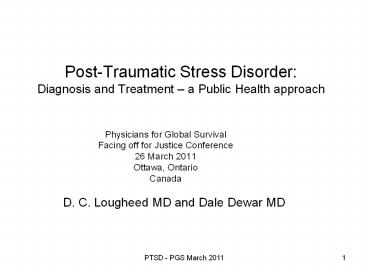Post-Traumatic Stress Disorder: Diagnosis and Treatment - PowerPoint PPT Presentation
1 / 14
Title:
Post-Traumatic Stress Disorder: Diagnosis and Treatment
Description:
Post-Traumatic Stress Disorder: Diagnosis and Treatment a Public Health approach Physicians for Global Survival Facing off for Justice Conference – PowerPoint PPT presentation
Number of Views:95
Avg rating:3.0/5.0
Title: Post-Traumatic Stress Disorder: Diagnosis and Treatment
1
Post-Traumatic Stress Disorder Diagnosis and
Treatment a Public Health approach
- Physicians for Global Survival
- Facing off for Justice Conference
- 26 March 2011
- Ottawa, Ontario
- Canada
- D. C. Lougheed MD and Dale Dewar MD
2
PTSD Diagnosis, Treatment and Prevention
- History of PTSD
- Case Presentation
- Diagnosis
- Military Context
- Civilian Context
- Making the Diagnosis
- Resources
- Challenges to Family Doctors
- Prevention
- Thanks to Dr Colin Cameron and Dr Chantal Whelan,
Ottawa, ON.
3
Criterion A Stressor
- The person has been exposed to a traumatic event
in which both of the following have been present - The person has experienced, witnessed, or been
confronted with an event or events that involve
actual or threatened death or serious injury, or
a threat to the physical integrity of oneself or
others. - The person's response involved intense fear,
helplessness, or horror.
4
Criterion B Intrusive Recollection
- The traumatic event is persistently
re-experienced in at least one of the following
ways - Recurrent and intrusive distressing recollections
of the event, including images, thoughts, or
perceptions. - Recurrent distressing dreams of the event.
- Acting or feeling as if the traumatic event were
recurring (includes a sense of reliving the
experience, illusions, hallucinations, and
dissociative flashback episodes, including those
that occur upon awakening or when intoxicated). - Intense psychological distress at exposure to
internal or external cues that symbolize or
resemble an aspect of the traumatic event. - Physiologic reactivity upon exposure to internal
or external cues that symbolize or resemble an
aspect of the traumatic event
5
DSM IV Post Traumatic Stress Disorder
6
Criterion C Avoidance/numbing
- Persistent avoidance of stimuli associated with
the trauma and numbing of general responsiveness
(not present before the trauma), as indicated by
at least three of the following - Efforts to avoid thoughts, feelings, or
conversations associated with the trauma - Efforts to avoid activities, places, or people
that arouse recollections of the trauma - Inability to recall an important aspect of the
trauma - Markedly diminished interest or participation in
significant activities - Feeling of detachment or estrangement from others
- Restricted range of affect (e.g., unable to have
loving feelings) - Sense of foreshortened future (e.g., does not
expect to have a career, marriage, children, or a
normal life span)
7
Impact of Events scale
8
Criterion D Hyper arousal
- Persistent symptoms of increasing arousal (not
present before the trauma), indicated by at least
two of the following - Difficulty falling or staying asleep
- Irritability or outbursts of anger
- Difficulty concentrating
- Hyper-vigilance
9
Criterion E DurationCriterion F Functional
Significance
- Criterion E duration
- Duration of the disturbance (symptoms in B, C,
and D) is more than one month. - Criterion F functional significance
- The disturbance causes clinically significant
distress or impairment in social, occupational,
or other important areas of functioning. - Specify if
- Acute if duration of symptoms is less than three
months - Chronic if duration of symptoms is three months
or more - Specify if
- With or Without delay onset Onset of symptoms at
least six months after the stressor
10
PTSD
- What can physicians do?
- Public Health Approach
- Primary prevention prevent the illness eg
vaccination polio - Secondary prevention diagnose and treat with
the goal of full recovery and prevention of
serious complications eg strep throat - Tertiary prevention treat with the goal of
reducing the burden of chronic illness or
disability eg osteoarthritis - What are the implications for prevention of the
disease called PTSD?
11
PTSD Military Populations
- Diagnostic issues
- Stigma
- Acute stress
- Concurrent disorders substance, mood, other
- Public Health model
- Innocculation basic training, training in
hostage situations - Acute proximity, immediacy, expectation of
return to function - Military resources for treatment
- Debriefing
- OSI clinics Ottawa (ROH), Halifax, others
- Vets groups self referral
12
PTSD Special Civilian Populations
- Immigrant and Refugee Populations
- Cross-cultural issues
- Is it depression, schizophrenia, bipolar illness,
substance abuse, dementia - Physical symptoms
- Stigma,
- Cultural explanations of illness
- Challenges for interpretors
- Chronic and severe mental illness
- Dramatic symptoms of psychosis that are difficult
to treat - May end up on ACT teams or with MH case managers
- High doses of neuroleptic medications with mood
symptoms not treated - Shelter clients refugees, borderline
intellectual abilities, language issues, cultural
experience of illness - Consider differential diagnosis including mood
disorders
13
PTSD - Conclusions
- When the response to treatment is poor, check for
history of trauma - Consider the diagnosis of PTSD in unusual
presentations of psychosis, especially in refugee
populations - Consider the use of a cultural interpreter.
- Use a rehabilitation (recovery) model of
treatment - 1. assess state of change-readiness
- 2. Help the patient set goals and review personal
strengths - 3. Emphasise gradual improvement if chronic,
rapid return to functioning if acute - 4. Importance of return to meaningful social
roles
14
With thanks to Grandchildren of Marvin N.
Lougheed MD FRCPC































